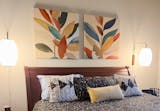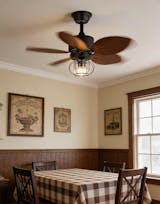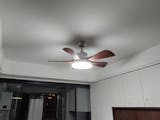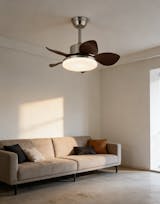Navigation
- Introduction
- What Kind of Light Makes You Sleep Better?
- What Makes a Table Lamp Ideal for Your Bedroom?
- How to Place a Table Lamp in Your Bedroom
- Let Your Table Lamp Lead You to Dreamland
Quick Answer
Looking to choose the optimal table lamp for a sleep-friendly bedroom? Go for adjustable warm white lamps around 2500K that support melatonin production, avoiding cool blue-toned lights over 5000K that can suppress it. Select compact table lamps around 20-25 inches tall or mini lamps under 18 inches to fit smaller nightstands. Direct light thoughtfully with adjustable shades, swing arms, and dimmers to prevent glare while resting. Pick lamp styles and materials that coordinate with your existing bedroom decor for cohesion. You can also consider convenient features like USB charging ports, alarm clocks, and smart controls, ensuring they are compatible first.
Introduction
Most of us strive to get a good night's sleep, but it can be frustrating when sleep remains elusive night after night. The right bedside lamp that provides optimal lighting for sleep can be a simple solution to transform your bedroom into a relaxing sleep sanctuary. In this article, we'll look at how different types of light affect sleep, the key features to look for in a sleep-friendly table lamp in a bedroom, and placement tips to make the most of your bedside lighting. With the right lamp for your bedroom, you'll be catching more restful z's in no time!
What Kind of Light Makes You Sleep Better?
When it comes to selecting a bedroom table lamp that won't interfere with your sleep, pay attention to the color temperature. Warm light tends to have yellowish-orange hues, similar to the colors of a sunset - think amber, gold, or yellow. Cold light is usually bluish-white like the midday sky - icy blue or bright white are good examples. Light color is measured in kelvins (K). Cooler white lights over 5000K mimic daylight, and studies show they suppress melatonin, making it harder to fall asleep. While warmer white light under 3000K does not inhibit melatonin production, making it ideal for nighttime lighting.
According to a study published on Science Direct in April 2023, exposure to warm light, characterized by a low Correlated Color Temperature (CCT) of 2000 K, was found to significantly improve sleep quality in the evening over a 21-day period. This study utilized a randomized controlled trial design to examine the impact of low and high Correlated Color Temperature (CCT) light environments on sleep quality in adolescents. The researchers recruited 66 adolescent swimmers who were randomly assigned to be exposed to either low CCT lighting at 2000 K or high CCT lighting at 8000 K over a period of 21 days.
Right from the start and continuing throughout the 3-week light intervention study, participants exposed to warm light (low CCT) reported higher quality sleep compared to those under cold light (high CCT). On average, the warm light group rated their sleep quality at 4.12 out of 5, versus 3.80 for the cold light group. Put simply, people sleeping under warmer-toned lighting slept better than those under cooler lighting, as illustrated by the line graph below.

Therefore, it is advisable to opt for table lamps for your bedroom that have replaceable bulbs with lower color temperatures, which represents warm light, around 2500K, to enhance melatonin levels at night. If you already have a lamp you love, simply swap out the existing bulbs for lower-wattage warm white ones to optimize them for sleep.
What Makes a Table Lamp Ideal for Your Bedroom?
When shopping for the perfect bedside lamp, there are a few key features and functions you'll want to keep in mind. Choosing a lamp with the right specs for your space can make a world of difference in creating your ideal sleep sanctuary.
Consider the Size
Before you get a bedside lamp, you'll want one scaled to fit your bedroom appropriately. Oversized lamps can overwhelm and clutter small nightstands. Aim for table lamps around 2 feet tall or under so they don't dominate. For pint-sized surfaces, mini lamps under 18 inches are just the ticket. And don't overlook sconces - those wall-mounted swing arm gems maximize space in cramped quarters.
Direct the Light Thoughtfully
Now let's talk lighting direction - this is key for a cozy bedtime ambiance. Seek out lamps with adjustable shades that can angle the beam towards the ceiling, providing soft, glare-free illumination. Swiveling shades are super handy for pivoting the light away from your eyes if you're reading before bedtime. Models with dimmers let you dial down brightness gradually as needed. Position and point your lamp to bathe your space in optimal lighting without eye strain.
Use Energy Efficient LED Bulbs
While we're at it, let's go green with energy-efficient LED bulbs. LEDs outlast incandescent bulbs by years and conserve energy to cut electricity costs. Even better, dimmable smart LEDs give you control over brightness and color temperature. There are even LEDs that mimic natural sunrise/sunset light to regulate your circadian rhythms. Just make sure your lamp is compatible before purchasing any bulbs.
Match Your Decor Style
Matching your table lamp style to the existing decor of your bedroom is a surefire way to create harmony in your space. Ceramic ginger jar lamps pair perfectly with traditional decor, while sleek metal numbers complement contemporary rooms. If farmhouse is your thing, wire cage lamps with burlap shades are made for you. Choose a lamp that complements your interior design style and helps your bedroom decor sing.

Consider Convenient Added Features
Many modern lamps bake in bonus convenient features too. Built-in USB charging ports let you power up bedside without a separate charger cluttering your nightstand. Integrated alarm clocks provide a gradual, peaceful wake-up call. Smart controls and touch dimmers put customizing your lighting at your fingertips. Just confirm that added features play nice with your lamp before buying. Focus on what will enhance your personal bedside experience.
Before you buy, make sure any added features play nicely with your space. For example, if you want color-changing lights, ensure the lamp is compatible with color smart bulbs. Don't forget about extra functions, too, like dimmable smart bulbs or USB charging ports, to make your bedside lamp even more convenient.
How to Place a Table Lamp in Your Bedroom
Now that we've covered choosing the right lamp, let's discuss optimal placement and usage for sleep-promoting lighting. Thoughtful positioning and simple adjustments can take your bedside lamps from potentially disruptive to sleep-enhancing. Follow these tips to make your lamps effective allies for better rest.
Strategic Lamp Positioning
First things first, consider strategic lamp positioning for optimal sleep. Place bedside lamps on the wall opposite the bedroom door to prevent light from shining in your eyes when the door opens at night. This will minimize disruptions. Also, you can angle lamps slightly away from the bed to reduce glare when they are switched on, as glare can hinder falling asleep.

Optimizing Light Direction
Light direction is also important to consider for a table lamp in a bedroom. Use swing arm sconces to adjust the light closer for reading and then lower when sleeping. Invest in table lamps with pivot shades that can angle the beam away from your eyes. Wall-mounted vertical lamps are also great for preventing direct glare.

Controlling Brightness
Don't forget about controlling brightness as well for better sleep. Install dimmer switches to lower light levels in the bedroom before bedtime. Program smart bulbs to mimic fading light for a gradual sunset mode. It's also best to stop using bright overhead and bedside lamps for 1-2 hours before trying to sleep.
Minimizing Blue Light
Minimizing blue light exposure from lighting and devices at night is also crucial. Choose amber or orange light bulbs, which have fewer blue wavelengths to disrupt sleep. Get bulbs with warmer color temperatures below 3000K. Avoid bright overhead and fluorescent lights late at night. Also, limit the use of TVs, phones, tablets, and other screens before bedtime.
With mindful lamp placement, directional adjustments, smart brightness controls, and reduced blue light exposure, you can transform your bedside table lamp into a sleep-friendly oasis in the bedroom. Implementing these tips will help your lamps support, rather than hinder, your much-needed rest. Careful setup and use can make all the difference.
Let Your Table Lamp Lead You to Dreamland
With the right warm-toned table lamp and conscientious setup, you can banish restless nights for good. By understanding and controlling lighting factors like color temperature, brightness, placement, and blue light exposure, you can create a sleep sanctuary tailored to your body's natural rhythms.
Ready to revolutionize your rest with a few simple lamp tweaks? Don't miss out on this small but powerful tweak that could help you slide into nights of deep, restful sleep. Your groggy mornings could soon be a thing of the past! Dim the lamps and let restful slumber embrace you night after night.
Read More
- Create an Inspiring Haven for Bookworms with Table Lamps | MetaVaya – Metavaya
- Illuminate Your Space with the Top Bedroom Table Lamp Trends of 2023 – Metavaya
- The 5 Best Floor Lamps for Living Room So You Never Have To Use" The Big Light" Again – Metavaya
- The Timeless Artistry of Isamu Noguchi's Akari Pendant Lights – Metavaya












